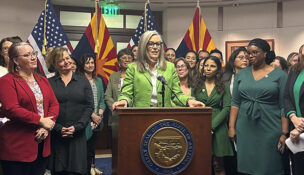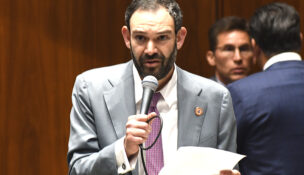Is Arizona prepared if a flu pandemic strikes?
Arizona Capitol Reports Staff//November 24, 2006//[read_meter]
Is Arizona prepared if a flu pandemic strikes?
Arizona Capitol Reports Staff//November 24, 2006//[read_meter]
The top public health official for Maricopa County doesn’t mince words regarding readiness for a flu pandemic and the possible human devastation that it would bring.
Dr. Bob England said he thinks he scares “the hell out of a lot of people” when he makes presentations to community groups.
“It’s an overwhelming set of issues to deal with here, and we’ve come a long ways in terms of recognizing our issues, doing some planning, setting up some initial processes and procedures, but honestly we have a very long way to go,” said Dr. England, head of the Maricopa County Public Health Department.
The virulent H5N1 strain of bird flu has killed 153 people worldwide, mostly in Asia, according to figures compiled by the World Health Organization.
Most of the human deaths from bird flu have been linked to close contact with infected birds, but experts fear the virus could mutate into a form easily spread from person to person and spark a worldwide pandemic that could kill thousands or even millions of people.
Those fears have spurred federal, state and local government officials to step up efforts to be prepared in case a pandemic hits the United States, leading to a scourge like the “Spanish flu” outbreak in 1918 or, more optimistically, a milder version such as those seen in 1957 and 1968.
vFederal funding herky-jerky
In Maricopa County, plans are incomplete and even the plan segments already written must be considered drafts because of the many unknowns. Federal funding has been herky-jerky. Flu-focused drills so far have largely focused on tabletop exercises that don’t involve practicing mass immunizations or other boots-on-the-ground work. Meanwhile, some supplies and essential gear have been acquired but other purchases must await detailed needs assessments.
“We’re trying to get a better handle on how much we actually need and how much we can store. Some supplies, not just medications, have shelf lives and you’ve got to figure out how to rotate through,” Mr. England said.
County readiness varies
Maricopa County’s situation isn’t unique among Arizona’s 15 counties, whose readiness varies widely, but it is one of the most daunting because of the county’s population of 3.6 million, said Will Humble, a deputy assistant director of the state Department of Health Services, who oversees public health preparedness statewide.
“You’ve got this enormous task and you’re in a county that’s bigger than many states,” Mr. Humble said.
The state earlier this year completed a sweeping revision of its pandemic readiness plan, and Mr. Humble said efforts are now focused on the county level.
“What we want to have is the county health departments make their specific plans and more important than that, to test the key elements of those plans,” he said.
Dr. England said some problems facing his county will have to be tackled with outright workarounds.
For example, because the Phoenix metropolitan area’s hospitals and clinics typically are jammed during regular cold and flu season, the situation will worsen during a pandemic because sick people — even some with regular flu — will be scared and go to the health facilities, Dr. England said.
“We have to set up some kind of system for checking on folks (at home by telephone) and weeding out the people who really need to come in,” he said.
And quality of care for those who do need treatment will require compromises, such as having relatives use handheld bags to ventilate people because there won’t be enough ventilator machines, Dr. England said.
The county has identified 100 sites for mass vaccinations but not the 20,000 or so people to staff those sites in 12-hour shifts.
“I don’t think that’s reasonable, so the trick is getting a core group of people and having a really good system for just-in-time training set up so that you can use the many walk-in volunteers who will undoubtedly show up,” Dr. England said.
Statewide, Mr. Humble said current efforts include trying to get the word out on the need for individuals, schools, businesses, churches and other organizations to begin their own planning, and Dr. England said he alone makes a half-dozen presentations a week.
“In a case of a pandemic, one of the big issues isn’t going to be related to health care per se,” Dr. England said. “It’s going to be: how do you keep society functioning with a very large absenteeism rate and a lot of people perhaps afraid of going to work? How do you keep the groceries getting delivered? How do you keep the gasoline delivered? How do you keep the lights on?”
It doesn’t help that nobody can say whether and when a pandemic will hit and, if it does, whether it’ll be horrendous or somewhat mild because the strain’s virulence could diminish or even worsen if it mutates to be transmittable from human to human.
“This one has gotten the press (coverage) partly because it’s hung around for so long and partly because it’s very bad — really, very lethal — so that makes people worried,” Dr. England said.

















